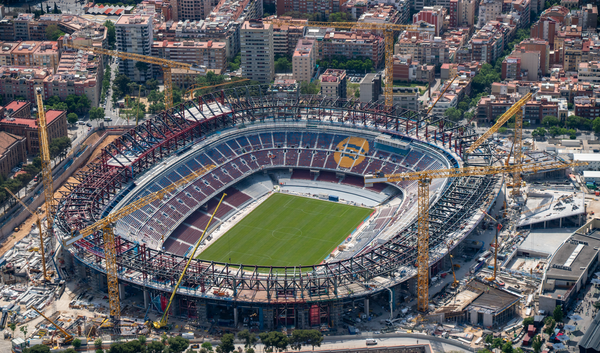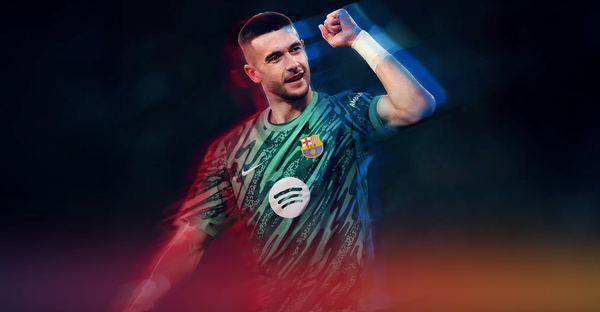Ferran Torres: A versatile dynamo for a static Barcelona frontline
Ferran excels in finding space. But would that be enough for him to cement a starting spot for Barca?
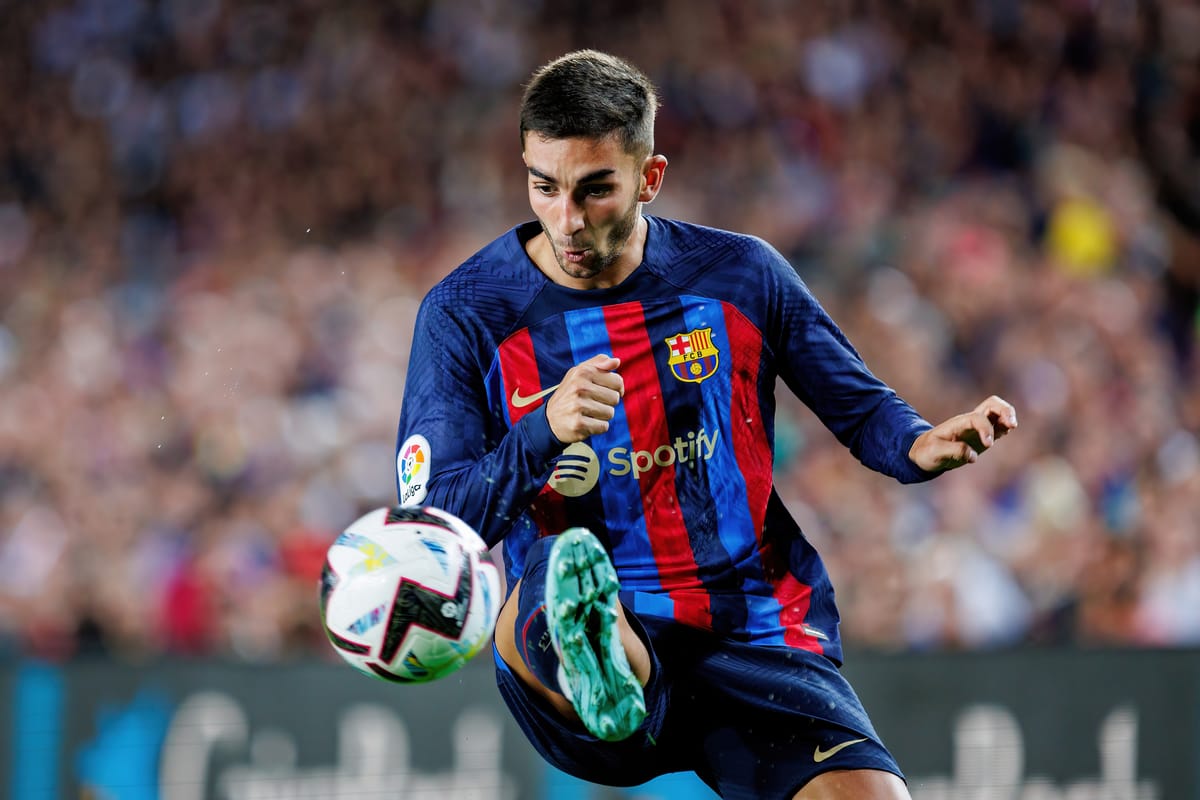
Even though his rather short stint at Pep Guardiola’s Manchester City wouldn’t suggest it, Ferran Torres is still one of the most talented young players on the planet. Of course, potential alone doesn’t guarantee future stardom but the foundations of a great player are here already. Barcelona, fortunately, have recognised that on time and were given a rare opportunity to (re)claim the ex-Valencia man after missing out on his signature a couple of years back.
And Valencia indeed played a huge part in his development. Born and raised in their city, Torres spent time as a prodigy in their academy and then as the star player both in the B and senior team alike before securing a lucrative transfer that would take him to the Premier League. At that time, the reported fee of ~€20M seemed like a bargain and while Barcelona had to pay more than double to secure him now, it still feels like a good, if not a slightly high price for someone of his potential.
In the right hands, Torres could take the next step. And Xavi is the type of coach to make proper use of the 21-year-old’s arsenal, just as Pep and Luis Enrique are too. Sadly, injuries played a part in both of their plans but the latter will still continue reaping the rewards of Torres’ development, just as Xavi could too.
At Barça, securing the right profile of players has been an ongoing struggle; an issue that’s still being rectified by the new hierarchy. Ferran, however, feels like a breath of fresh air because his profile, for all intents and purposes, is different and heavily needed for the current Catalan squad.
So without further ado, let’s explore his skill set and see what he excels at, what are his weaknesses and how can Xavi get the best of him.
Let’s go.
Versatility and/of movement
One huge aspect of Ferran’s profile is his versatility. Even though he has played across the frontline even during his stay at Valencia, he was mostly a wide player in Albert Celades’ 4-3-3 and Marcelino García Toral’s 4-4-2. This continued in the first season at Manchester City in Guardiola’s 4-3-3 but the tinkerer he is, Pep didn’t wait long to diversify Torres’ profile and deploy him in a more central role as the striker or even as the false nine. For now, I’ll focus more on his latest stint as that provides the newest ‘update’ on his profile.
Below, you can see his Manchester City heatmap along with an action map from a game where he spent time both as a winger and as a centre-forward for the Citizens. There are a couple of things both maps can tell us about his movement. Firstly, Torres likes to hug the touchline as a winger but will move in-field when the opportunity presents itself. Secondly and in a rather similar fashion, in a central role, he still likes to drift to the half-space and drop deeper to link up with the midfield.

Remember, however, that both maps show his on-the-ball activity rather than the off-the-ball one. This is important as I’ll touch upon his off-the-ball movement a bit later. On the ball, however, he is still very effective. One of the big traits we have to discuss in his profile is dribbling. At City, this wasn’t as evident as a big weapon in his arsenal because of the largely central role Pep deployed him in. Without going too deep into that right now, aspects such as close control, quick decision-making and the ability to manipulate/overcome markers in tight spaces are qualities that were more on display in that role.
Dribbling, however, is best seen in Ferran the winger rather than Ferran the striker/false striker. The 21-year-old is mostly ambipedal, meaning he can use both of his feet on a similarly high level. This is important as it suggests the possibility of deploying him on both the right flank - as a more natural winger - and the left one - as the inverted winger. In fact, this was the case during his Valencia days, albeit to a smaller extent as he still prefers the right side of the pitch. But even more importantly, using both feet is highly advantageous in dribbling scenarios. You see, players generally have a tendency to dribble towards their strong foot or simply start the dribble with it. This means a right-footer on the right is likely to dribble towards the outside and start the dribble with his right foot. Of course, this can make them more predictable but not necessarily easier to stop. If a right-footer on the right starts the dribble with his right but decides to cut inside, it means he has to carry the ball across his body, making it easier for the defender to tackle. However, if you’re ambipedal, you eliminate that risk by being able to dribble both ways with both feet equally well. Not to mention this plays a huge part in the shooting as well, which I’ll discuss a bit later.
Nevertheless, Torres still heavily prefers his right foot when dribbling, even when cutting in-field. In general, I’ve identified two main strategies when trying to beat a marker. His turn of pace is a good weapon in both staying wide and cutting in scenarios but when going in-field he will rely on it more. The following sequence shows it well.
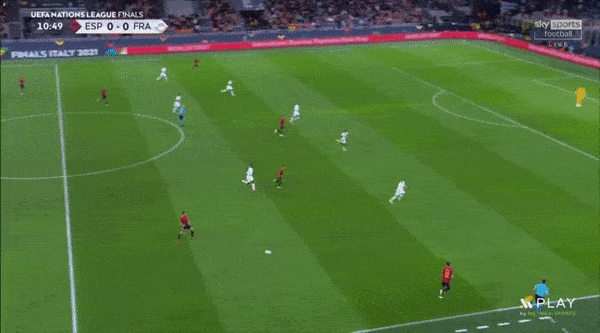
Torres starts out wide as the winger in Lucho’s Spain but upon receiving possession, he cuts in centrally, starting both attacking duels with his right foot. Notice how he drags the ball across his body while accelerating rather quickly, ultimately beating both markers. I’ve decided to use this particular sequence because it’s interesting on multiple levels. Firstly, it shows us his tendencies in movement perfectly - start wide, end up more centrally and even inside the box.
Secondly, notice Gavi’s (#9) movement towards the outside. This is key because it foreshadows what Barcelona could do well too, only I’d presume it would be either Nico González or Frenkie de Jong charging into space to receive the ball or drag markers, creating space for someone else’s run. We’ve actually seen a very similar combination with Abde Ezzalzouli and Ilias Akhomach performing similar roles on Barça’s right with their respective midfielder in tow.
Thirdly, we have to highlight the excellent pass into the feet of his teammate in that same sequence. This sort of link-up is crucial for Xavi’s system but remains something Ferran still has to work on, as I’ll explain shortly. Finally, the insistence to continue his run into the box for a potential cut-back is important here as it shows something Barcelona have lacked for a long time. This also brings us nicely to perhaps the most important part of his profile - the off-the-ball movement.
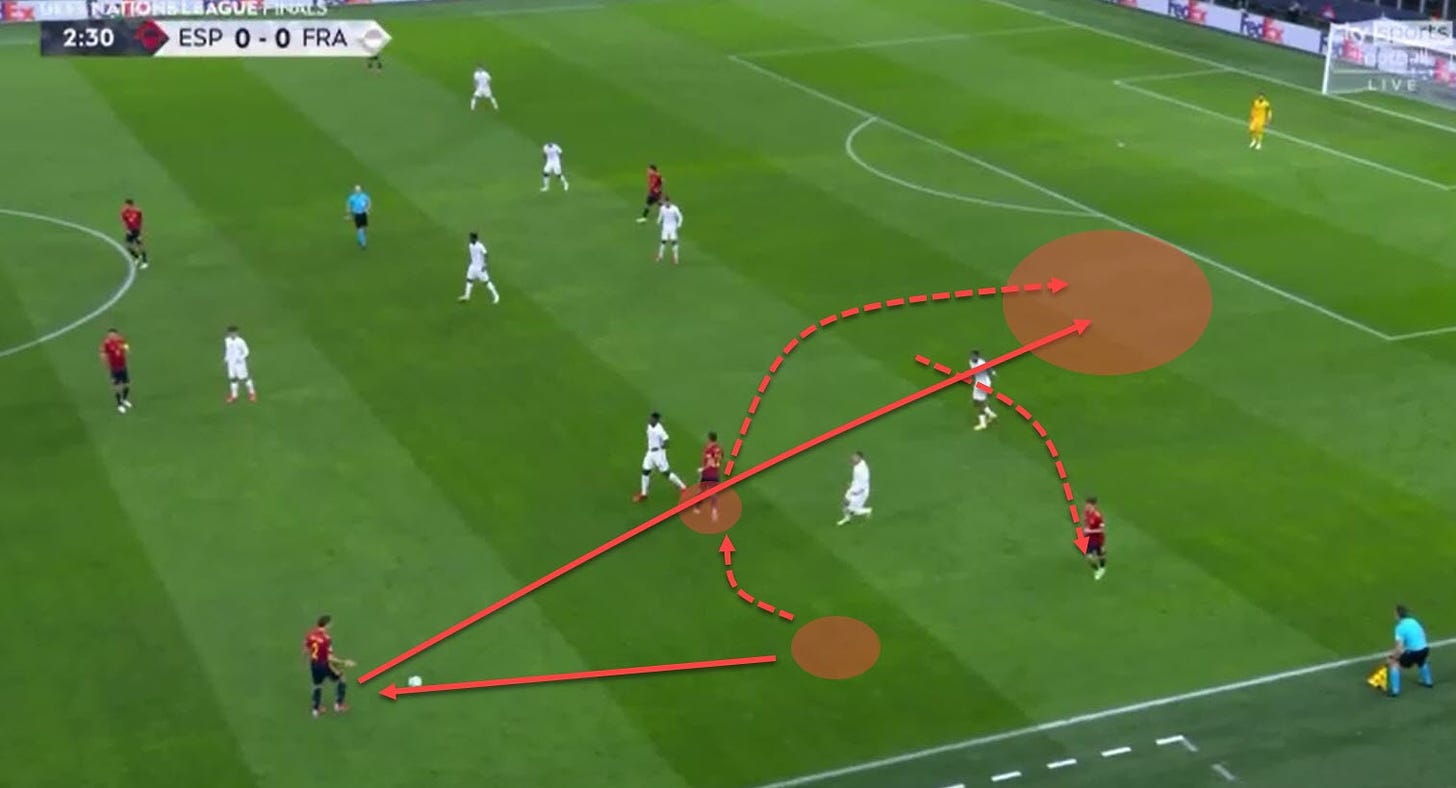
Again we come back to that same Spain game under Lucho. Notice the combination play here. Torres starts the sequence out wide but immediately upon playing the ball back to César Azpilicueta, he cuts inside, swapping places with Gavi and even more importantly, attacking the space behind France’s backline. Azpilicueta then lobs the ball towards him but the pass gets intercepted before anything can come out of it. Nonetheless, this is something Barcelona can and, in my opinion, will look to replicate in the future. Let me explain why.
Even though it’s more likely Torres arrives at the Camp Nou as a striker, in the long-term, he’ll likely be a winger because Joan Laporta - and perhaps even Xavi - want a more traditional striker for that #9 position (Haaland, anyone?). In that scenario, with a pure striker down the middle, Ferran would start on the right, rotating with or replacing Ousmane Dembélé, depending on the Frenchman’s future at the club. And then, we could expect this sequence to be quite common, especially with a right-back such as Dani Alves behind them, who, in this stage of his career, can be found deeper and more centrally in a pseudo-midfielder/inverted full-back role. So Gavi drifting wide, Torres cutting in and Alves pinging balls over the top could indeed be in Barça playbook. And honestly, it should be too.
Of course, cutting inside also works well if the Catalans want to pursue the more common overlapping right-back route. We saw the same with Daniel Wass at Valencia, for example. Similarly, Torres can easily hold width and run towards the outside if needs be. This is where we touch upon his second dribbling technique - the feint. Ferran can quickly change directions and do little feints akin to Lionel Messi, albeit, of course, not as devastating. This is mostly used when he tries to dribble towards the outside of the pitch, advancing down the flank as opposed to cutting in. But all of that was for Ferran the winger. So what about Ferran the (false) striker?
Link-up & passing
‘He came as a winger, but he can be a number nine. The smell – the strikers know intuitively where the ball will arrive. He has that talent.’ commented Guardiola back then. And this is largely true - Ferran can indeed play as a striker because of that killer instinct. However, here, I’d like to first discuss his link-up play in the false nine role before touching upon the inside-the-box ‘smell’, to use Pep’s terminology. The idea behind the false nine is already well-known. A ‘false’ striker will often drop deep to put defenders into a decisional crisis - do they follow and leave space behind their back or maintain the structure, risking their man moving unmarked? Similarly, having an additional player in midfield gives teams a better chance of achieving numerical superiority in crucial parts of the pitch.
Torres will indeed often drop deep for both of those aforementioned reasons but to mixed effect. His excellent technical quality ensures he can control the ball in tight spaces and he mostly does that. At the same time, we’ve seen he has an eye for a good pass so combination play is something he can do too. Case in point, the next image.

This is an example of a good link-up play. Torres drops deeper to open a passing channel for his teammate and immediately upon receiving the ball, he lays it off to the right before darting into the space behind Leicester City’s backline. Textbook modern #9 sequence. The movement to drop deep and run back is excellent too. The pass, while mostly basic, is also executed well, which isn’t always easy, especially with a marker on your back.
Let’s take a look at a fairly similar example next. Even though he starts high, Torres does a quick feint and drops deep to link up with the backline, offering a progression channel for the Citizens. It has to be mentioned that his link-up is mostly very basic. Not that there’s anything wrong with that but many modern strikers or false nines take up roles of playmakers in that position. Ferran can advance up the pitch via his progressive runs and dribbling but playmaking isn’t such a prevalent aspect of his profile for now.
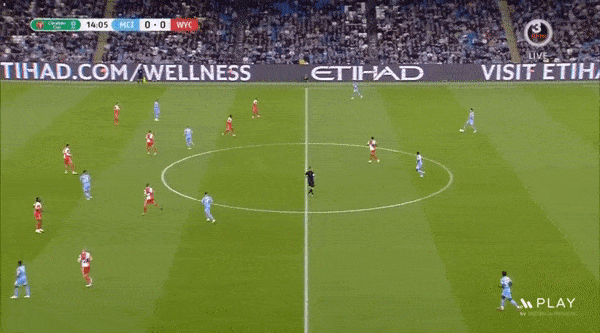
But it’s also important to once again make note of his tendency to immediately push back up after laying the ball off to a teammate. The movement is key to overloading the opposition and allowing the progression but he also continues the sequence by attacking the space behind the backline. Again, with this, I’m emphasising his off the ball penetration that will be key for Barcelona who are lacking players of such profile.
That being said, generally it feels like his false nine role is underdeveloped. Both of his technical and physical attributes are lacking in this aspect. Standing at 184 cm (6'0'') and weighing 74 kg, Ferran is not a brute and lacks the ability to properly shield the ball and play with his back to goal. Not that false nine players always have to do that but winning duels between the lines and operating in tight spaces with markers constantly collapsing on you will inevitably force him into far more complex situations. Especially compared to the wide winger role since Xavi loves to isolate his wide men in 1v1 duels on the flanks. False nine players rarely get that luxury.
But physicality is not as big of an issue here, technical quality is. I’ve mentioned Torres has good control and that hasn’t suddenly changed. However, he still struggles when receiving with a marker on his back and can be uncertain how and what to do in such scenarios. Take the following sequence as a good example.
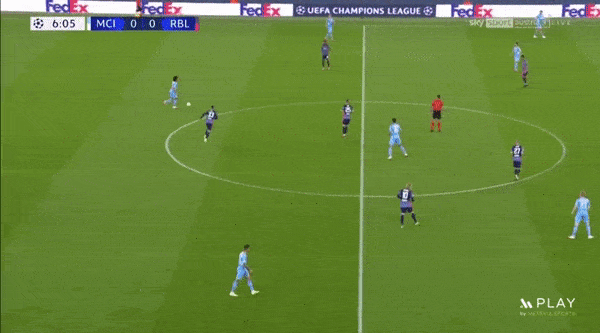
Even though the play still ends in Manchester City retaining possession, Torres had visible issues controlling the ball and combining with his teammates, losing a lot of ground in the process. And this isn’t an isolated case either but I’ll only include one for now. With a mix of those two issues and his limited passing repertoire in such scenarios, it’s difficult to expect a lot from Torres in that role. Of course, that doesn’t immediately discard it as an option but it shows his strengths lie elsewhere and this remains something to be further developed.
So let’s see what Pep was on about with that killer instinct, shall we?
Shooting & finishing
The final aspect I’ll discuss in this analysis concerns the final product. However, just as is the case with everything in football, you can’t look at it in isolation. For that reason, this section will also discuss his movement once more. Before we do exactly that, let’s consult some data to see what kind of a finisher we’re talking about here. Below is a shot map, courtesy of Wyscout, and it analyses his last 75 attempts, excluding penalty kicks.
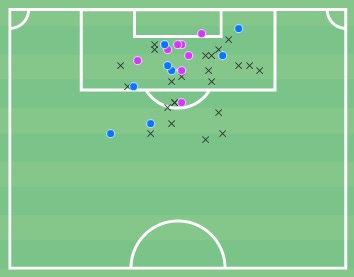
What the map does well is give us the locations and shooting tendencies. We can see that all of his goals come from the central channel, which is very good because it’s generally the best position to make an attempt from. Similarly, that’s why Pep saw him as a good striker option. Notice that the shots from the right are largely inaccurate and didn’t yield any goals so cutting in from the flank lands him in suboptimal positions to shoot from despite his ambipedal nature. However, the central ones are largely successful and account for almost all of his goals.
When we dive into the numbers a bit more, we can see he’s truly got an almost poacher-like instinct, both in the execution and the movement. In the sample of his last 32 shots, nine have been on target in addition to seven goals, which makes for 50% accuracy. However, when we break it down even further, we get to some of his tendencies in front of goal. Out of the 32 shots, 20 have been one-touch finishes, accounting for five shots on target and a total of six goals. This solidifies the poacher claim even more.
Torres’ goals often come from close range and from high-quality chances. In fact, six of his last seven goals were uncontested (he was free from any real marking) and five of the seven have come with an expected goals (xG) value between 0.23-0.5, which is a high figure. As far as the shooting technique goes, the shots were mostly divided between softer finishes with the inside of the foot (12 shots, three on target, four goals), favouring placement over power, and stronger finishes with the top of the foot (12, three, one respectively). Similarly, 17 were attempted with his right, nine with the left foot and six with the head, accounting for a well-rounded spread, confirming the versatile approach I’ve talked about before. So how does he actually do it?
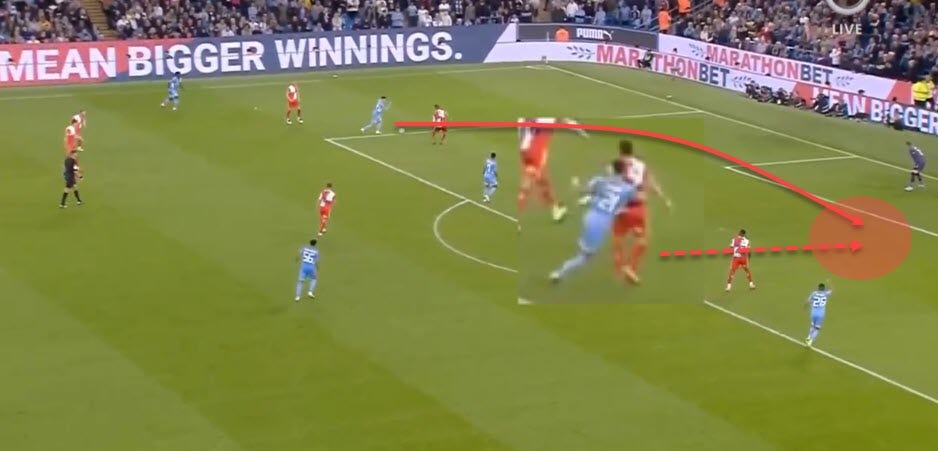
Once again, it’s a lot to do with his movement, which is amazing. ‘He [Ferran Torres] makes movements like the best strikers moving behind, like Jamie Vardy.’ remarked Pep when talking about the youngster and he was right, of course. Torres is extremely good at utilising the defenders’ blindspot, as well as accelerating quickly, changing directions before the marker can react in the same way. Above, you can see that feint we already discussed.
Here it’s executed so well it leaves the defender wrong-footed as he’s put all of his weight on his left side while Ferran moves in the opposite direction. That way, he can get to the ball uncontested for a rather simple tap-in. Yes, it’s a lot about being in the right place at the right time but the details preceding that are crucial too. Next, I’ll analyse two other goals to get more insight into his movement and finishing.
The first one is very similar. Ferran successfully repositions himself after a quick feint and then proceeds to attack the space between the two defenders as Spain advance down the flank. But the trick is to mask his run from the marker, staying behind Alessandro Bastoni so that the young centre-back isn’t even fully aware of what’s going on behind him.

The subtle feint might not seem like much here but overall, it plays a huge role in Torres’ (re)positioning. Since he does it way quicker than the defenders, it’s an effective tool to create separation and attack the space with a split-second advantage. A foot-race with such dynamic superiority will always be in favour of the attacker and Ferran uses it really well.
Interestingly, the second and final example comes from the same game against Italy in the UEFA Nations League semi-final. Again, Spain are advancing down their left side and Ferran makes a good run into the Azzurri box. The ball bounces around before Mikel Oyarzabal sends an excellent cross to his 21-year-old teammate on the other side of the six-yard area. Torres’ headed finish is excellent but once more it’s the movement that precedes it that’s key here.
Notice that subtle change of direction just before the separation from the defender is achieved. It happens quickly but still changes the outcome of the duel or rather, the duel that never was because Torres was completely unmarked and had all the time in the world to time his jump perfectly.
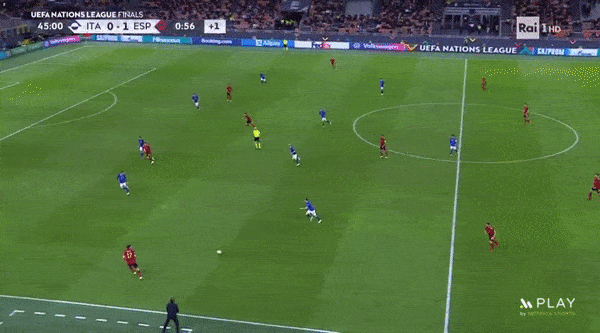
One remark on his shooting and finishing I have concerns long shots. Out of the last 32 shots, only eight have been attempted outside the box and none have hit the target. While this is very poor, at least it shows Torres doesn’t attempt shots from distance that often, recognising it’s a flaw in his versatile weaponry. However, it would be beneficial for his overall profile and development to aim to improve this aspect. After all, Barcelona lack long-range shooters in the team.
Nonetheless, considering the player they’re getting with this transfer, it’s safe to say it’s a great match on paper. Not only is Torres extremely versatile and can plug multiple Barça’s holes but he also adds a completely new and dynamic profile into their frontline. With so much technical quality in their side, most of their players ask for the ball into feet. Ferran, on the other hand, is not afraid to attack and exploit space.
His inclusion offers a lot of different structural options as deploying him on either flank or centrally can yield a positive outcome. However, it will be up to Xavi to find the perfect formula to get the best out of this incredible but still raw young talent.


